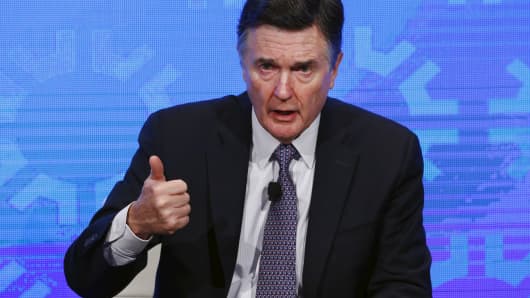The U.S. economy is barely growing, but it's expected to keep moving ahead fast enough to prompt Federal Reserve officials give serious thought to raising interest rates when they meet next week.
That view was offered up by Atlanta Fed President Dennis Lockhart on Monday to a group of business economists, who issued a fresh forecast that calls for continued subpar growth.
Despite the slow advance of overall economic expansion, Lockhart pointed to other signals that it may be time to nudge rates higher.
"If 1.6 percent inflation and 4.9 percent unemployment were all you knew about the economy, would you consider a policy setting one tick above the zero lower bound still appropriate?" Lockhart said in a Monday morning address at the National Association for Business Economics.
"I think circumstances call for a lively discussion next week," he said.
While historically low inflation and jobless rates may bolster the case for higher interest rates, the recent slow pace of overall economic growth continues to give some Fed members pause.
That slow growth is expected to continue, according to the NABE's latest quarterly survey, released Monday.
The business economists expect the U.S. economy to avoid a recession for at least the next two years, but they continue to lower their projections for growth.
The group's median estimate sees gross domestic product growing at an annual rate of 1.5 percent in 2016, down from their June forecast of 1.8 percent. Their median outlook for next year sees growth picking up a bit, to 2.3 percent average annual growth.
The economists also see the pace of hiring slowing; they've cut their June forecast of 201,000 jobs per month to just 185,000 monthly payroll gains in the latest survey. They expect payroll growth to slow to 168,000 a month next year, with the jobless rate falling to 4.6 percent by the end of 2017.
The recent pickup in wage growth is expected to slow — from 2.9 percent last year to 2.6 percent this year. But the group sees wage growth picking up again next year, to 3.1 percent, rising faster than inflation both years. They expect inflation to remain tame at 1.6 percent this year, rising to 2.2 percent next year.
Lockhart told the group that recent data and contacts with business officials in his southern region leave him confident that job growth will continue and inflation will eventually rise toward the Fed's target.
Though not ruling out some of the more pessimistic arguments of his colleagues who feel the economy may be in a low-growth rut, he regards the economy as "chugging along, not stalling out."



